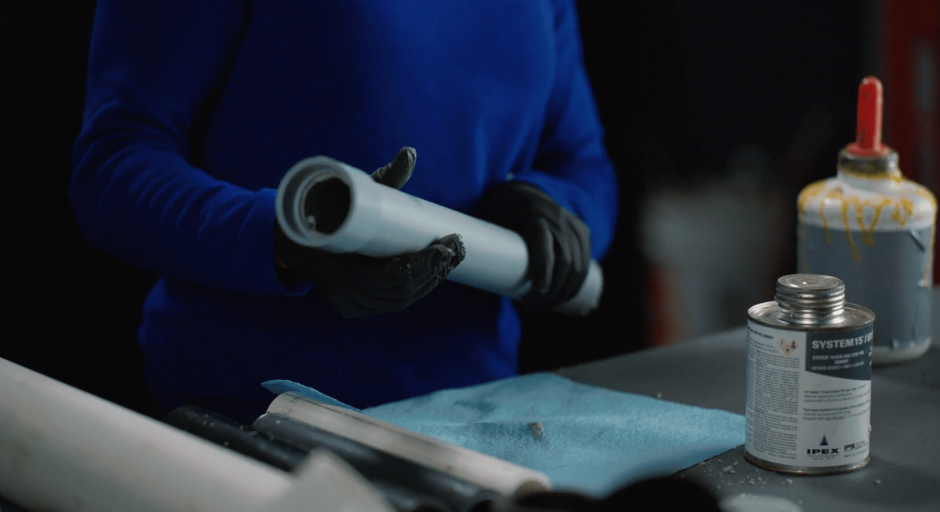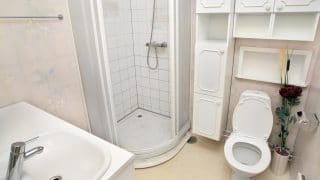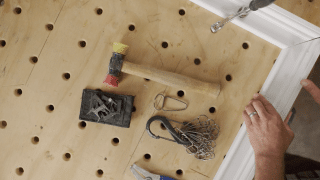
PVC is best known as a piping material. However, from clothing to water bottles, PVC is a versatile plastic that is used in several industries. Here, we’ll take a closer look at how it’s used in plumbing.
What is PVC?
PVC, or polyvinyl chloride, is a thermoplastic that is used in many industries, including construction, healthcare, clothing, and consumer goods. It’s a strong, versatile plastic that can last a long time. First created in 1872, PVC was commercially produced by BF Goodrich Company in the 1920s. Since then, it’s become widespread.
Some of the most significant properties of PVC are:
- Density. PVC is dense compared with other plastics.
- Low-cost. PVC is readily available and inexpensive.
- Rigidity. Rigid PVC ranks well for hardness and durability.
- Strength. Rigid PVC has excellent tensile strength, meaning it takes a lot of force to stretch and break it.
Forms of PVC
PVC comes in two forms: rigid PVC, or RPVC, and unplasticized PVC, or uPVC. The rigid version is used for piping, wiring insulation, clothes, and more. Though it’s not flexible, it is strong and durable. And it’s one of the most common materials used for piping in the US.
CPVC, a type of water piping, is created by adding chlorine to RPVC. CPVC is fire-resistant and often used for sprinkler systems and drinking water piping.
uPVC, or unplasticized PVC, is used in window frames and siding. It is rigid and often used to replace wood in building applications. uPVC is also used for piping, and remains most popular outside the US. It can be used to replace cast-iron for heavy-duty plumbing pipes.
How is PVC used in construction?
PVC is used for piping, flooring, siding, and windows. The piping is usually leak-free, as the plastic doesn’t crack or break easily. Because it is not prone to corrosion, it can be used both indoors and outdoors.
Flexible PVC is used to create flooring like vinyl tiles and sheet flooring, as well as wall coverings and wire and cable insulation. It’s used in many industries like health care and education because it is water-resistant and easy on feet.
PVC is best known as a piping material. However, from clothing to water bottles, PVC is a versatile plastic that is used in several industries. Here, we’ll take a closer look at how it’s used in plumbing.
What is PVC?
PVC, or polyvinyl chloride, is a thermoplastic that is used in many industries, including construction, healthcare, clothing, and consumer goods. It’s a strong, versatile plastic that can last a long time. First created in 1872, PVC was commercially produced by BF Goodrich Company in the 1920s. Since then, it’s become widespread.
Some of the most significant properties of PVC are:
- Density. PVC is dense compared with other plastics.
- Low-cost. PVC is readily available and inexpensive.
- Rigidity. Rigid PVC ranks well for hardness and durability.
- Strength. Rigid PVC has excellent tensile strength, meaning it takes a lot of force to stretch and break it.
Forms of PVC
PVC comes in two forms: rigid PVC, or RPVC, and unplasticized PVC, or uPVC. The rigid version is used for piping, wiring insulation, clothes, and more. Though it’s not flexible, it is strong and durable. And it’s one of the most common materials used for piping in the US.
CPVC, a type of water piping, is created by adding chlorine to RPVC. CPVC is fire-resistant and often used for sprinkler systems and drinking water piping.
uPVC, or unplasticized PVC, is used in window frames and siding. It is rigid and often used to replace wood in building applications. uPVC is also used for piping, and remains most popular outside the US. It can be used to replace cast-iron for heavy-duty plumbing pipes.
How is PVC used in construction?
PVC is used for piping, flooring, siding, and windows. The piping is usually leak-free, as the plastic doesn’t crack or break easily. Because it is not prone to corrosion, it can be used both indoors and outdoors.
Flexible PVC is used to create flooring like vinyl tiles and sheet flooring, as well as wall coverings and wire and cable insulation. It’s used in many industries like health care and education because it is water-resistant and easy on feet.
Window frames and siding are also made from uPVC and help consumers save energy. Vinyl window frames, for instance, provide three times the heat insulation of aluminum windows.
Advantages of using PVC
Both durable and versatile, PVC offers many advantages in plumbing.
- Strong and durable. Recyclable PVC pipe hardly cracks or breaks compared to cast-iron pipe. It can also last for at least 50 years.
- Affordable. Compared to materials like wood or copper, PVC is cost-effective, giving you value for your money.
- Lightweight. PVC materials are lighter than other building materials, making them less expensive to transport.
- Fire-resistant. The high chlorine and low oxygen content of PVC’s plastic makes it fire-resistant.
- Chemically resistant. PVC rarely reacts when it comes into contact with other substances such as oils, inorganic acids, fats, salts, bases, and alcohols.
- Versatile. PVC can be molded into a variety of shapes and forms, as well as integrated into fabrics for durability.
Disadvantages of using PVC
There are a few disadvantages of PVC to keep in mind.
- Releases toxins. When PVC burns, it emits dioxin and hydrogen chloride, two highly toxic chemicals. Manufacturing facilities working with PVC must have specialized ventilation equipment to handle the fumes.
- Not biodegradable. Although it can be recycled, PVC will sit in the trash for a long time because it does not disintegrate.
- Can’t be used in heat or UV. PVC can break down when it comes in contact with heat or UV rays, so it can’t be used outdoors or to pipe hot water.
PVC is a versatile material that can be used in several industries. While it can be toxic during the manufacturing process, the end product is completely safe for consumers to use, as evidenced by drinking water. This affordable building material provides strength and durability and can be used to replace materials like wood effectively.
MT Copeland offers video-based online classes that give you a foundation in construction fundamentals with real-world applications, like plumbing basics. Classes include professionally produced videos taught by practicing craftspeople, and supplementary downloads like quizzes, blueprints, and other materials to help you master the skills.







